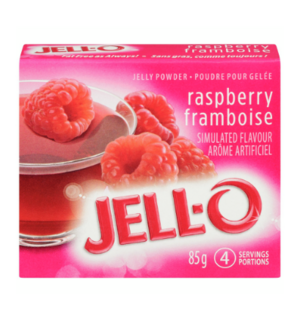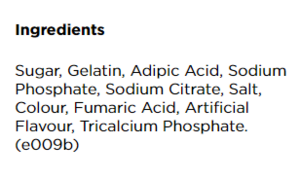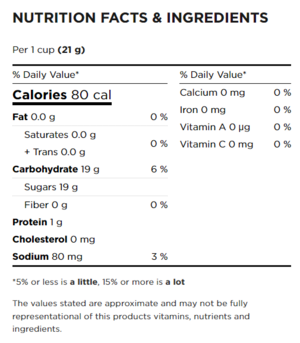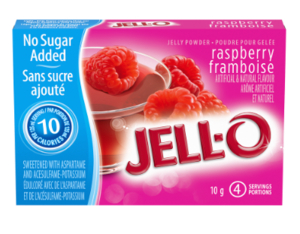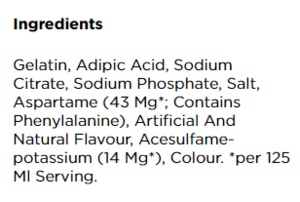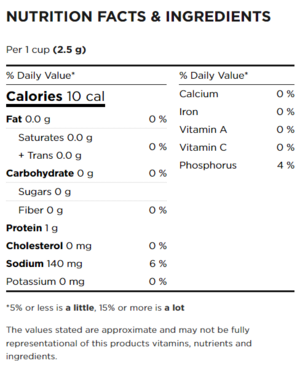Course:FNH200/Assignments/2023/KraftHeinz Jell-O Raspberry Classic Vs. Sugar Free
A registered trademark of Kraft Heinz, Jell-O is an American Brand that offers a variety of fruit flavoured gelatin based desserts, pudding, and no-bake pie mixes that comes in many Ready-to-make, premade, and prepackaged forms[1].
First introduced in 1897, Jell-O's most classic dishes is the original gelatin desert that is offered in Strawberry, Raspberry, orange, and lemon flavouring[1]. Popularized by it's ease in home preparation (by just adding water to the mixture and allowing to sit in the fridge for a few hours to make the perfect dessert every time) and low cost to purchase, Jell-O has become a staple to American Diets and is now a world wide dessert that is readily consumed[1].
Description
Raspberry Jell-O (classic and it's sugar free alternative) is sold in Canada in a powdered form that contains gelatin, flavouring, and includes either sugar or artificial sweeteners[1]. To prepare it, the powder is dissolved in hot water, chilled and allowed to set before consumption. Many families enjoy adding fruits, vegetables, and whipped cream to make the snack more elaborate and enjoy putting the dessert into molds for party settings[1].
Pictures
| Jell-O Flavour and Style | Product Front | Ingredients | Nutrition Facts |
|---|---|---|---|
| Raspberry, Classic | |||
| Raspberry, Sugar Free |
Ingredients and Understanding
Bolded ingredients are identified as sugar substitutes, fat substitutes, or additives
Raspberry Jell-O (Classic) Ingredients
Sugar, Gelatin, Adipic Acid, Sodium Phosphate, Sodium Citrate, Salt, Colour, Fumaric Acid, Artificial Flavour, Tricalcium Phosphate
Raspberry Jell-O (Sugar Free) Ingredients
Gelatin, Adipic Acid, Sodium Citrate, Sodium Phosphate, Salt, Aspartame (43 Mg*; Contains Phenylalanine), Artificial and Natural Flavour, Acesulfame-Potassium (14 Mg*), Color. *per 125 Ml Serving
| Ingredient | Role In Food | Purpose in Food |
|---|---|---|
| Sodium Phosphate[2] | Additive | An additive that is used to maintain freshness, alter texture and a variety of other effects |
| Adipic Acid[3] | Additive | Although natrually found in beets and sugar cane, here it is added to give a tart flavouring to the products |
| Sodium Citrate[4] | Additive | An additive that is used for its flavor and preservation (preservative) |
| Colour[5] | Additive | An additive that is used to enhance natural colors and add color to otherwise colourless foods |
| Fumaric Acid[6] | Additive | An additivie that is an organic food acid and is used as a sour flavouring agent |
| Artificial Flavour[7] | Additive | An additive designed to mimic the taste of natural flavourings and ingredients |
| Tricalcium Phosphate[8] | Additive | An Additive that is added to boost calcium content |
| Aspartame[9] | Sugar Substitute | An artificial sugar substitute that is about 180-220 times sweeter than sucrose and is partially absorbed by the body (4 cal/g) |
| Acesulfame-Potassium[9] | Sugar Substitute | An artificial sugar substitute that is not digested by the body and is about 200 times sweeter than sucrose. |
Why the differences?
The sugar free version of the Raspberry Jell-O uses the sugar alternatives as well as natural flavouring to bring back the original tase of the classic product. Two different sugar substitutes are used to prevent complete degredation of sweetness, provided by Aspartame, when exposed to the hot water and extend the shelf-life of the sugar-free variation.
Labels
Below is a detailed description of the information found on the labels of both Jell-O products, which adhere to regulatory requirements as outlined in Lesson 4.
Raspberry Jell-O (Classic)
Bilingual labelling: All mandatory information on Jell-O label is shown in both official languages, i.e., French and English.
Common name of the food: Complies with requirements outlined on the CFIA website. Jello-O if commonly known on its own in Canada, but they have also included it’s prescribed name, Jelly powder. This way if there are any areas in Canada where people are not commonly understanding Jell-O, this would still be compliant because the term “Jell-O” could be seen as just the supplemental term while the prescribed common name, jelly powder is present.
Date marking and storage instructions: Jelly powder has a storage life of over 90 days, so this is not present but still compliant.
Identity and Principal Place of Business: Provided on the sides of the packaging.
Irradiated foods: Not marked as irradiated because it is not irradiated so it is still compliant.
Legibility and location: Common name: Jello-O and jelly powder are both on principal display panel. Net quantity: 85g is on principal display panel. List of ingredients: at the back of the box which complies with requirements. Durable life date: Does not apply because jelly powder lasts more than 90 days. Name and Principal place of business: Kraft Heinz Canada, Toronto Ontario M3B 3L6. Nutrition labeling: nutrition facts are displayed on the back of the box and complies with regulations that it must be on one continuous surface.
List of ingredients in descending order of proportion: Sugar is listed first because that is the biggest proportioned ingredient.
The Nutrition Facts table: shows that it is 80 Calories, 0.0g of Fat, 0.0g of saturated and trans fats, 0mg of cholesterol, 80 mg (3%) of sodium, 19g (6%) of carbohydrate, with 0g fiber and 19g sugars, 1g protein, 0mg calcium, 0mg iron and 0 Vitamins A and C in 1 cup (21g) of their jelly powder.
Net quantity of the food: 85 g (4 servings)
Sweeteners: Not present on the front panel because it is sweetened with sugar.
Raspberry Jell-O (Sugar Free) Ingredients
Bilingual labelling: All mandatory information on Jell-O label is shown in both official languages, i.e., French and English.
Common name of the food: Complies with requirements outlined on the CFIA website. Jello-O is commonly known on its own in Canada, but they have also included its prescribed name, Jelly powder. This way if there are any areas in Canada where people are not commonly understanding Jell-O, this would still be compliant because the term “Jell-O” could be seen as just the supplemental term while the prescribed common name, jelly powder is present.
Date marking and storage instructions: Jelly powder has a storage life of over 90 days, so this is not present but still compliant.
Identity and Principal Place of Business: Provided on the sides of the packaging.
Irradiated foods: Not marked as irradiated because it is not irradiated so it is still compliant.
Legibility and location: Common name: Jello-O and jelly powder are both on principal display panel. Net quantity: 10g is on principal display panel. List of ingredients: at the back of the box which complies with requirements. Durable life date: Does not apply because jelly powder lasts more than 90 days. Name and Principal place of business: Kraft Heinz Canada, Toronto Ontario M3B 3L6. Nutrition labeling: nutrition facts are displayed on the back of the box and complies with regulations that it must be on one continuous surface.
List of ingredients in descending order of proportion: Gelatin is listed first because that is the largest proportion. It is then followed by Adipic Acid, Sodium Citrate, Sodium Phosphate, Salt, Aspartame (43 Mg*; Contains Phenylalanine), Artificial and Natural Flavour, Acesulfame-Potassium (14 Mg*), Color.
The Nutrition Facts table: shows that it is 10 Calories, 0.0g of Fat, 0.0g of saturated and trans fats, 0mg of cholesterol, 140 mg (6%) of sodium, 0.0g of carbohydrate, with 0g fiber and 0g sugars, 1g protein, 0mg calcium, 0mg iron and 0 Vitamins A and C, and 4% phosphorus in 1 cup (2.5g) of their jelly powder.
Net quantity of the food: 10g (4 servings)
Sweeteners: Present on the front panel on the lower left side.
Personal Choice
Please submit your individual component of this assignment on Canvas to protect your privacy and your personal opinion
References
- ↑ 1.0 1.1 1.2 1.3 1.4 "Jell-O". Wikipedia. Retrieved July 22, 2023.
- ↑ "Sodium Phosphate". Healthline. Retrieved July 22, 2023.
- ↑ "Adipic Acid". ATPCroup. Retrieved July 22, 2023.
- ↑ "Sodium Citrate". ATPGroup. Retrieved July 22, 2023.
- ↑ "Color Additives Questions and Answers for Consumers". FDA. Retrieved July 22, 2023.
- ↑ Reboli, Evan. "What Is Fumaric Acid and How Can It Be Used?". Ingredi.com. Retrieved July 22, 2023.
- ↑ "NATURAL & ARTIFICIAL FLAVORS: HOW ARE THEY DIFFERENT?". Flavourman. Retrieved July 22, 2023.
- ↑ Lefton, Jennifer. "What Is Tricalcium Phosphate?". Verywell Health. Retrieved July 22, 2023.
- ↑ 9.0 9.1 Chan, Judy. "Types of Sugar Substitutes - Sweeteners". Canvas. Retrieved July 22, 2023.
